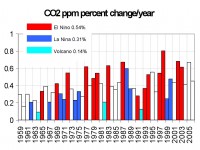Update by Joe D’Aleo, Icecap
Thursday, November 15, John Coleman, the founder of the cable TV Weather Channel and currently TV meteorologist in San Diego at KUSI began a series of short briefs trying to explain in simplified terms for the layman why he does not believe in global greenhouse warming on his KUSI climate blog.
Below was his original statement that got much national attention. KUSI and Icecap received hundreds of emails, better than 90% favorable, thanking John for his courage in speaking out on this issue and thanking KUSI and Icecap for covering the news the networks won’t cover. There were of course some negative responses mostly ad hominem attacks questioning motivation as is typical in this issue. Some requested John follow up with some concrete facts in understandable terms and he will begin to do that. The first brief on that link will address the ‘hockey stick”.
By John Coleman
It is the greatest scam in history. I am amazed, appalled and highly offended by it. Global Warming; It is a SCAM. Some dastardly scientists with environmental and political motives manipulated long term scientific data to create an illusion of rapid global warming. Other scientists of the same environmental whacko type jumped into the circle to support and broaden the “research” to further enhance the totally slanted, bogus global warming claims. Their friends in government steered huge research grants their way to keep the movement going. Soon they claimed to be a consensus. Read the rest of the original blog here.

By Corinne Purtill, Arizona Republic
Arizona State University climatologist Robert Balling attended the premiere of Al Gore’s global-warming documentary, An Inconvenient Truth. He served on the United Nations’ climate-change panel and studies how drought and warmer temperatures will affect the West. He bikes to work and eats organic food. But environmentalists hate him. Balling, 54, has spoken and written extensively against the widely held scientific view that the documented rise in global temperatures is the result of human activity and that serious consequences will result.

Despite his notoriety as a hero of the skeptic crowd, Balling’s research and lifestyle contain some surprising contradictions. He is in charge of climate studies at the Decision Center for a Desert City, an ambitious ASU program that looks at how drought will affect the Valley. He’s a registered independent and lives a lifestyle that the hardiest environmental activist would recognize as green. His outspoken views and the criticism they get have put ASU in an awkward position as it tries to shape itself as a leader in climate-change studies, ASU officials said. Balling seems bemused by his reputation among activists. “Somehow I’ve been branded this horrible person who belongs in the depths of hell,” he said. “There’s just no tolerance right now.” Read more here.
By Joseph D’Aleo, CCM
In a Newsweek article this week, Sharon Begley reported that during the time Andrew S. Grove spent at Intel, the computer chip company he co-founded, the number of transistors on a chip went from about 1,000 to almost 10 billion. Over that same period, the standard treatment for Parkinson’s disease went from L-dopa to . . . L-dopa. Grove (who beat prostate cancer 12 years ago and now suffers from Parkinson’s) thinks there is something deeply wrong with this picture, and he is letting the pharmaceutical industry, the National Institutes of Health and academic biomedicine have it.
What stands in the way of more and faster success in getting cures to patients? “The peer review system in grant making and in academic advancement has the major disadvantage of creating conformity of thoughts and values.” Grove said
I would argue the same applied in the climate sciences. Just last month, a paper in Nature reported the Scientific Consensus on Man-Made Ozone Hole May Be Coming Apart. Nature reported that new experimental data threatened to shatter established theories of ozone chemistry. If the data are right, scientists will have to rethink their understanding of how ozone holes are formed and how that relates to climate change. “Until recently everything looked like it fitted nicely,” agrees Neil Harris, an atmosphere scientist who heads the European Ozone Research Coordinating Unit at the University of Cambridge, UK. “Now suddenly it’s like a plank has been pulled out of a bridge.” You may recall that two decades ago, the scientific ‘consensus’ and the scare that the destruction of our protective ozone layer could lead to increased cancer risks, led to the Montreal Protocol and the banning of chlorofluorocarbons, used in spray cans and air conditioning and refrigeration.
Now with again a push from environmentalists, we have a new ‘consensus’ based on circumstantial evidence, in this case, global temperature which have oscillated up and down regularly for centuries, but which for two decades have paralleled increases in carbon dioxide. The theory of greenhouse warming took flight and was supported by research biased by a peer review process polluted with ideology. Even as temperatures level off and begin to decline, the global warming gravy train is accelerating down the track with politicians and scientists with government grants in hand jumping on board and calling for immediate action on major, sure to be enormously costly, programs to control our use of energy and potentially many other aspects of our lifestyle.
As Andrew Grove has advocated for medical research, we need a research revolution in the climate sciences and an open door peer review process to facilitate pure research to better understand the major unknowns in our science - how land use changes affect climate, water vapor, cloudiness, the ocean circulations that exhibit multidecadal behavior, all the many aspects of solar output, aerosols and so on. Otherwise twenty or ten or even just five years from now we will find planks to the greenhouse warming bridge pulled and we will again find that we have spent our precious money and time unwisely with some people very rich, most the rest of us and our national economies in far worse financial shape and with so many real dire needs in our country and around the world unresolved.
An excellent talk by Dr. Bob Carter was fortunately recorded to video and accesible through this story by Noel Sheppard of Newsbusters. Also you may see Dr. Carter’s May 2007 paper “The Myth of Dangerous Human-Caused Climate Change “in the Climate Library here.
Green Alps Instead of Perpetual IceBy Michael Breu, ETH Zurich’s Weekly Web Journal
Glaciers are widely considered as indicators for global warming. Several glacier and climate experts now present new studies with astonishing results. The current decline of the glaciers, according to these studies is not unique. Far from it: over the past 10,000 years these slopes of the Alps have been green more than once.
Many studies now strongly suggest that there is something wrong with this hockey stick model that Michael E. Mann of the University of Virginia published in 1999 in Geophysical Research Letters. A further challenge to the model now appears in an investigation from Christian Schlüchter, Professor for Quaternary and Environmental Geology at the Institute of Geological Sciences at the University of Berne, lecturer at ETH Zurich and a keen Alpine scientist. In the immediate vicinity of the lower Aar glacier in the Bernese Oberland in the high tide deposits of the glacier stream, Schlüchter found–amongst other things-pieces of wood that were between 30 and 60 centimetres thick and the remains of a moor. He examined and carbon dated the samples in the laboratory. What he found was quite astounding: “The age indicated by the data is not a chaotic cloud of data spread over the past 10,000 years but falls into clearly definable time windows,” says Schlüchter. “Until now we have managed to identify ten time windows. Taken over the last 10,000 years this means that, for more than half that period, the glaciers were shorter than they are today.“ In other words, since the last ice age our glaciers have rarely been as extended as they are today.
See this paper and others here that detail the wood and peat findings in the Alps that undermine the hockey stick climate model.

The Susten pass, as it might have appeared in Roman times, around 2000 years ago. The Stei glacier has retreated to the level of the Tierberg hut (2795 m), the tree level lies clearly higher. Picture: from “Die Alpen“ / Atelier Thomas Richner based on a draft from Christoph Schlüchter. See larger picture here.
See also this Climate Audit post on the latest attempt to keep the hockey stick alive. CO2 Science also has documented many studies worldwide that show prior warmth (Medievel Warm Period).

It was already late fall and the Indians on a remote reservation in South Dakota asked their new chief if the coming winter was going to be cold or mild. Since he was a chief now in a modern society, he had never been taught the old secrets. When he looked at the sky, he couldn’t tell what the winter was going to be like.
Nevertheless, to be on the safe side, he told his tribe that the winter was indeed going to be cold and that the members of the village should collect firewood to be prepared. But, being a practical leader, after several days, he got an idea. He called the National Weather Service and asked, “Is the coming winter going to be cold?”
“It looks like this winter is going to be quite cold,” the meteorologist at the weather service responded. So the chief went back to his people & told them to collect even more firewood in order to be prepared. A week later, he called the National Weather Service again. “Does it still look like it is going to be a very cold winter?” “Yes,” the man at National Weather Service again replied, “it’s going to be a very cold winter.” The chief again went back to his people and ordered them to collect every scrap of firewood they could find.
Two weeks later, the chief called the National Weather Service again. “Are you absolutely sure that the winter is going to be very cold?” “Absolutely,” the man replied. “It’s looking more and more like it is going to be one of the coldest winters we’ve ever seen.”
“How can you be so sure?” the chief asked. The weatherman replied, “The Indians are collecting firewood like crazy.”
In a May 18, 2007 blog entitled ”Could this Year Be the Northeast’s Hurricane Year?” we noted “History tells us during the warm Atlantic (phase), New York and New England is also more vulnerable to a direct hit. History also tells us this is more likely during La Nina summers. In fact in the 11 La Nina summers when the Atlantic was warm since the middle 1930s, there was at least one landfalling storm from the east coast of Florida to New England in every year with a total of 15 storms, 9 of the storms affected the northeast directly or indirectly.”
It was looking like this year might be the first exception but now late season Hurricane Noel looks destined to make some noise in eastern Long Island, Cape Cod and the Islands later Saturday. It was a CAT 1 Hurricane but quickly transformed from warm core to extratropical Friday. Despite this change, the storm will maintain its strength and hurricane force winds (at least in gusts) are likely in Nantucket and perhaps other spots as the storm races north-northeast and makes landfall by Saturday night on Nova Scotia.
Had it made landfall just 4 days later, it would have become a rare Snowcane as cold air would have been in place in the northeast. As it is as it moves through eastern Canada the next few days it will draw in enough cold air to have snow in the backlash. By the way, despite all you hear about this winter being a warm one for much of the country because of La Nina, this particular combination of factors usually means a colder La Nina for the central and eastern United States with frequent snows across the northern tier and periods with frequent Alberta Clipper lows. Look for snow on the ground even in some of the big northern cities before Thanksgiving.
 For a larger image click here. For a real-time loop go here.
For a larger image click here. For a real-time loop go here.
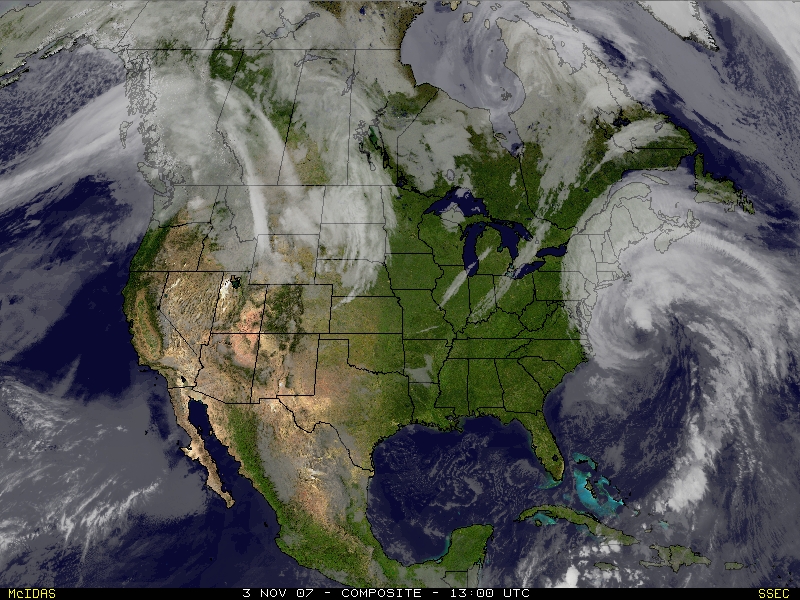
By John R. Christy in The Wall Street Journal
I’ve had a lot of fun recently with my tiny (and unofficial) slice of the 2007 Nobel Peace Prize awarded to the Intergovernmental Panel on Climate Change (IPCC). But, though I was one of thousands of IPCC participants, I don’t think I will add “0.0001 Nobel Laureate” to my resume.
The other half of the prize was awarded to former Vice President Al Gore, whose carbon footprint would stomp my neighborhood flat. But that’s another story.Large icebergs in the Weddell Sea, Antarctica. Winter sea ice around the continent set a record maximum last month. Both halves of the award honor promoting the message that Earth’s temperature is rising due to human-based emissions of greenhouse gases. The Nobel committee praises Mr. Gore and the IPCC for alerting us to a potential catastrophe and for spurring us to a carbonless economy.
I’m sure the majority (but not all) of my IPCC colleagues cringe when I say this, but I see neither the developing catastrophe nor the smoking gun proving that human activity is to blame for most of the warming we see. Rather, I see a reliance on climate models (useful but never “proof") and the coincidence that changes in carbon dioxide and global temperatures have loose similarity over time. There are some of us who remain so humbled by the task of measuring and understanding the extraordinarily complex climate system that we are skeptical of our ability to know what it is doing and why. As we build climate data sets from scratch and look into the guts of the climate system, however, we don’t find the alarmist theory matching observations. Read more here.
By Ryan N. Maue, Florida State University
Unless a dramatic and historical flurry of activity occurs in November and December, 2007 will rank as a historically inactive TC year for the Northern Hemisphere as a whole. During past 30 years, only 1977 has had less activity to date Jan 1-Oct 31. For the period of June 1 - Oct 31, only 1977 has experienced LESS tropical cyclone activity than 2007. October stats are complete. For the North Atlantic basin, one should always be prepared for late-season developments since hurricane season continues until the end of November. 2007 had the lowest September activity on record since 1977. 2006 and 2007 had the lowest October activity on record since 1976 and 1977
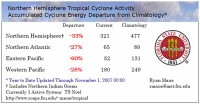
See full size image here. See full story at FSU here.
Icecap Note: Ironically the Pacific was undergoing the Great Pacific Climate Shift in 1976 and 1977, the last time we were this quiet. We appear to be again in the midst of another Great Pacific Climate Shift back to cold. Perhaps with these transitions, there is enough chaos in global weather patterns to reduce tropical system organization in most or all of the hurricane regions. Take that together with the prospect of a major decline in the solar activity that appears more and more likely with each and every day the next solar cycle is delayed (already cycle 23 is the longest since the early 1900s), the prospects that we will see an acceleration down in global temperatures, which peaked in 1998 by most measures, grow. If Global Warming was a stock, I would be selling.

By Cliff Ollier, School of Earth and Geographical Sciences, The University of Western Australia in Benny Peiser’s CCNet
Hansen is a modeller, and his scenario for the collapse of the ice sheets is based on a false model. Hansen has a model of an ice sheet sliding along an inclined plane, lubricated by meltwater, which is itself increasing because of global warming. The same model is adopted in many copy-cat papers. Hanson’s model, unfortunately, includes neither the main form of the Greenland and Antarctic Ice Sheets, nor an understanding of how glaciers flow.
The global warming doomsday writers claim the Greenland and Antarctic ice sheets are melting catastrophically, and will cause a sudden rise in sea level of 5 or more metres. This ignores the mechanism of glacier flow which is by creep. Glaciers are not melting from the surface down, nor are they sliding down an inclined plane lubricated by meltwater. The existence of ice over 3 km thick preserving details of past snowfall and atmospheres, used to decipher past temperature and CO2 levels, shows that the ice sheets have accumulated for hundreds of thousands of years without melting. Variations in melting around the edges of ice sheets are no indication that they are collapsing. Indeed ‘collapse’ is impossible. Read more here. An expanded version with additions and references by CSPP can be found here.
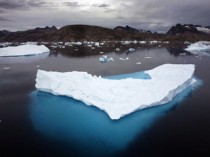
By Lord Christopher Monckton of Brenchley
Kevin Trenberth (Rocky Mountain News, October 24), commenting on Mike Rosen’s article expressing legitimate doubts about the award of the Nobel Peace Prize to Al Gore, makes 23 scientific mistakes, each of which falls in the direction of magnifying the unjustifiable alarm stoked by panicky politicians and extravagantly-funded environmentalists in cahoots with a shrinking clique of scientists in denial of observational climate data.
For example, Trenberth says the most recent warming was “not from 1900 to 1940, but after 1970.” In fact, according to the land and sea temperature records of the National Climate Data Center the rate of warming in the 1920s and 1930s, before humankind had much influence on climate, was as great as it was in the 1980s and 1990s. Since the IPCC’s previous report in 2001, there has been no statistically-significant “global warming” at all.
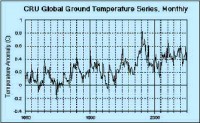
Also, Trenberth says, “Gore’s statement that ice-sheets melting in Greenland or the West Antarctic would raise sea level by 20 feet is correct, although it was misleading that he did not put a time-frame on this.” Though Trenberth “played a major part” in the IPCC process, he somehow failed to point out that the IPCC itself has said that temperatures would have to remain 5.5 degrees Celsius higher than today’s for several millennia before the Greenland ice sheet would lose even half of its ice. The Greenland ice sheet has in fact recently thickened by 2 inches per year – a total of 20 inches in 10 years (Johannesen et al., 2005).

See more here.
Settling on an Unstable Alaskan Shore: A Warning Unheeded
By World Climate Report
An intense storm struck the northwestern tip of Alaska during the fall of 1963. This storm caused over 3 million dollars in damage, primarily to the U.S. Government research camp that was located at Barrow, AK, as 55mph winds (gusting to 75mph) and waves topping 10 feet pushed a storm surge over the 10 foot high protective beach. The storm hit during an unusual ice-free period in early October—the primary reason why the seas grew to such damaging heights. During most months there, near shore sea ice coverage is sufficient to dampen (or prevent entirely) the build up of significant wave heights. James Hume and Marshall Schalk, described the damage from the 1963 storm in an article written for the journal Arctic in 1967 and based upon historical weather records and the recollection of Inuit elders, reckoned that the storm was about a “200 year” storm.
This storm, and others like it, should have served as ample warming against settling on the unstable coastline of much of Alaska. Instead, today we here repeated reports of recently-established native Alaskan villages having to be moved inland because of an encroaching ocean—and the culprit is always anthropogenic global warming, never lack of foresight.
Clearly, erosion has been gnawing away at the Alaska coast for many, many decades and this fact has been known for equally as long. Wind and waves acting on soil held together by ice acts through a positive feedback to expose more frozen soil to the above-freezing temperatures of summer and the warm rays of sunshine, softening it for the next round of waves and wind. And so the process continues. A decline in near-shore ice cover helps to exacerbate the process. Ignoring these well-known environmental conditions has led to the unfortunate situation today where Inuit villages are facing an imminent pressure to relocate. This situation has less to do with anthropogenic climate change than it does to poor planning in the light of well-established environmental threats—threats that have existed for at least the better part of the 20th century. Read full report here.
By Joseph D’Aleo, CCM
While the networks and some politicians are implying global warming is to blame for the fires in the southwest, the unfortunate fires can be explained very nicely by natural factors. La Ninas are more frequent when the Pacific Decadal Oscillation is in its cold phase (see this blog). The Pacific was in that phase from 1947 to 1977 and then briefly from 1998 to 2001 (with 3 of 4 years in La Nina). It has returned back to the cold phase in recent months and a moderate La Nina has ensued.
You can see clearly from the following correlation chart of La Ninas (using the Southern Oscillation Index) with precipitation from CDC, that La Ninas favor dryness in the southwest.
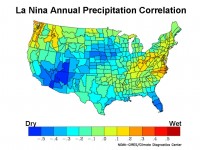
The cooling in the Pacific caused the past El Nino winter (2006/07) rains to fail in California. That means the region has undergone drought for 18 months. This combined with unwise policy that Dr. Scott Campbell reported on yesterday concerning the prohibition against clearing up accumulated brush from the areas surrounding housing developments that were instituted at the insistence of the Sierra Club and other environmental groups has left more fuel for the fires fanned by the Santa Ana winds, which as Dr Patzert indicated, in a recent linked to release, were also more common in La Ninas.
A few years back McCabe, Palecki and Betancourt published a paper that looked at drought frequency across the United States related to both the Pacific Decadal Oscillation and the Atlantic Mulitdecadal Oscillation. Droughts in the United States were more frequent when the Atlantic was in its warm mode. When the Atlantic was warm, and the Pacific was also in its warm mode, the dryness was more across the northwest and southeast and when the Pacific was cold more across the southwest. We are currently in the warm Atlantic and cold Pacific mode and thus should expect the dryness in the southwest. See these maps and read more here.
When I was Dr. Dewpoint for Intellicast, I found and reported that the monthly records for most tornadoes from the fall through the spring were in La Nina years. The worst tornado outbreak, The Superoutbreak of 1974” came after one of the strongest La Ninas.
In recent weeks, Eugenio Hackbaart of the Brazilian METSUL Meteorologia, observed a similarity with seasonal weather patterns in southern Brazil and North America in corresponding seasons. This lead him to suggest we may be surprised by some of the cold here this upcoming winter.
He wrote to me last night and indicated that Brazil experienced a significant severe weather outbreak with very large damaging hail and tornadoes and he wondered whether the same relationship I found with the severe weather here in La Ninas applied to their region. He forwarded two links that show some remarkable photographs of hail and hail and tornado damage. See the hail photos here and the tornado damage photos here. Though the text is in Portuguese, the photos require no translation. The holes in the roof were common and included tin roofs. The damage was in the state of Rio Grande Do Sul in southern Brazil.
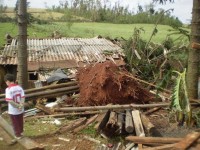
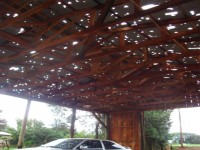
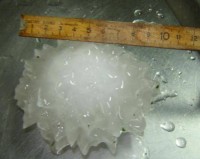
By Joe D’Aleo, CCM and Dr. Madhav Khandekar
As reported by the AP, “Carbon dioxide emissions were 35 percent higher in 2006 than in 1990, a much faster growth rate than anticipated, researchers led by Josep G. Canadell, of Australia’s Commonwealth Scientific and Industrial Research Organization, report in Tuesday’s edition of Proceedings of the National Academy of Sciences. The changes “characterize a carbon cycle that is generating stronger-than-expected and sooner-than-expected climate forcing,” the researchers report.” Alan Robock, associate director of the Center for Environmental Prediction at Rutgers University, added: “What is really shocking is the reduction of the oceanic CO2 sink,” meaning the ability of the ocean to absorb carbon dioxide, removing it from the atmosphere. The researchers blamed that reduction on changes in wind circulation, but Robock said he also thinks rising ocean temperatures reduce the ability to take in the gas.”
As we showed in an earlier blog, though estimates of man’s output of carbon dioxide have increased in the last two decades, the rate of increase in the atmosphere has not increased, implying the opposite, a “missing sink” or underestimated ability of nature, primarily the oceans, to remove the excess carbon dioxide, the exact opposite of what Robock at Rutgers and the alarmists at CSIRO are implying. Never mind they are ignoring the fact that there has been no warming globally in the last 9 years.
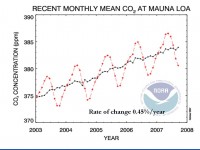
See in this blog the real story about carbon dioxide increases, how they relate to El Nino and La Nina and volcanic activity, that the oceans are cooling and not warming and why with a moderate La Nina underway, the rate of increase this year will probably drop dramatically.
